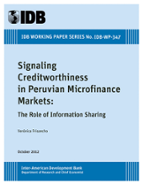Signaling Creditworthiness in Peruvian Microfinance Markets: The Role of Information Sharing
Date
Oct 2012
Using borrower-level data from FINCA, one of Peru's leading microfinance institutions (MFIs), this paper evaluates the effect on borrowers' access to credit of FINCA's decision to share information on individual outstanding debt records (positive information) as well as group default records (negative information). Since all borrowers were simultaneously exposed to the same policy, the paper develops a creative identification strategy that relies on the exogenous variation of the opening and closing dates of loan cycles across lending groups. A credit expansion effect is identified for some borrowers in FINCA who looked more creditworthy after their positive records were exposed, suggesting that other lenders targeted FINCA clients with good credit records. This credit expansion effect seems to have hurt FINCA through higher default rates as its better clients were skimmed off.



